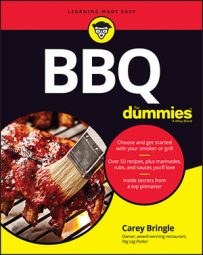Why buy a smoker? Well, there are many reasons. A dedicated smoker allows you to fully focus on the art of smoking. It allows you to hone some skills that may be useful when you move up to the big leagues of smoking.
Buy a smoker because you love to smoke great food or because you want to work on perfecting the craft of smoked meats.
You can get smokers in many different types, sizes, and shapes, but you may want to start off small to get the feel of your particular barbecue style.
If you're interested in how to smoke food with a charcoal or gas grill, check out my book BBQ For Dummies.
The more you get into smoking, the more you realize that you want a consistent temperature throughout the smoker. As you progress in your particular style, you get to know what you want and you can tune your cooking to the particular setup you’re cooking on. Be patient!Standing up to a vertical smoker
A vertical smoker is an upright cooker with the firebox on the bottom and the cooking chamber directly above it (see the photo below). The upright configuration utilizes the natural tendency of heat to rise with the heat source on the bottom and cooking surface on top, making it very efficient.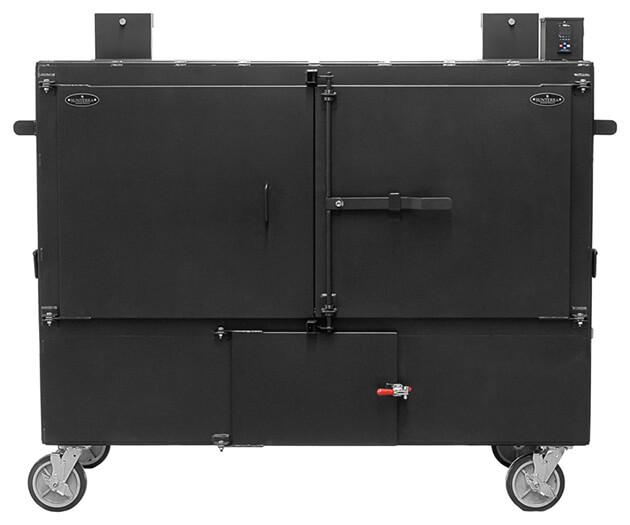 ©Sunterra International
©Sunterra InternationalA vertical smoker
A vertical smoker is probably the best entry level smoker, and it’s readily available. You can choose from charcoal versions, gas versions, and electric versions of vertical smokers.
Vertical smokers are great for smaller cuts of meat because they have tall, thin chambers; however, some great professional verticals can handle much larger cuts, including a whole hog. They have a small footprint and typically give you a good amount of cooking space.
The bottom line on a vertical smoker is that it takes up a small amount of space and is usually very efficient, which makes it a great choice for a backyard enthusiast.
Vertical smokers can get much hotter up top. Just like horizontal smokers, they need to be tuned to make sure that the heat is as even as you can get it. Higher-end, more expensive verticals are tuned, whereas cheaper models are just letting the heat rise in a natural manner and make no effort to eliminate hot spots.Some vertical smokers on the market are really just a smoker with a fire pan on the bottom; the meat hangs above a fire in the bottom or sits on grates above a fire. The heat rises, so you have a very efficient smoker. Other verticals have a baffle system so the meat isn’t directly above the flames of the firebox.
In a baffled vertical smoker, a dampening system keeps the fire from coming into direct contact with the meat. That system may be a plate that’s slightly smaller than the body of the cooker, so it allows the heat to rise up and around the perimeter of the plate, or it may be a water pan, which also adds moisture to the meat while cooking.
Some cooks like to fill the water pan with something other than water to bring a specific flavor to the meat as it cooks. You can use orange juice, apple juice, vinegar and water — the sky’s the limit. Whatever you choose, make sure that you keep an eye on the liquid level. You don’t want it to evaporate and leave you with a burnt pan.
If you use a water pan in your smoker, make sure that you’re truly smoking low and slow. If you cook at too high a temperature with a water-pan smoker, you end up steaming your meat rather than smoking it, which isn’t what you want.
Just as in a horizontal smoker, a vertical can be reverse flow to promote better circulation. In this case, air usually travels between an inner and outer wall and is dumped on the top of the cooking chamber. The air is then forced down to vents in the bottom back wall of the cooking chamber that then exhausts the smoke. This method provides a more even temperature throughout the entire chamber.The table below lists pros and cons of various vertical smokers.
Vertical Smokers: Pros and Cons
| Type | Example | Pros | Cons |
| Top feeding | Weber Smokey Mountain Cooker Smoker Pit Barrel |
Efficient Very affordable |
Reloading charcoal can be frustrating May have to move meat to reload fuel |
| Front feeding | Masterbuilt | Easy to load and maintain Firebox door opens separately from the chamber door No heat loss with refueling |
Can have big temperature differences between the top and the bottom |
Siding with an offset smoker
An offset smoker smokes food in a chamber separate from the heat source, which is in a different chamber attached on one side. The smoker usually has a horizontal body where you place the meat; the wood or charcoal burns in the firebox to the side of that chamber (see the photo below). Heat flows through the body of the smoker and out the chimney on the other side.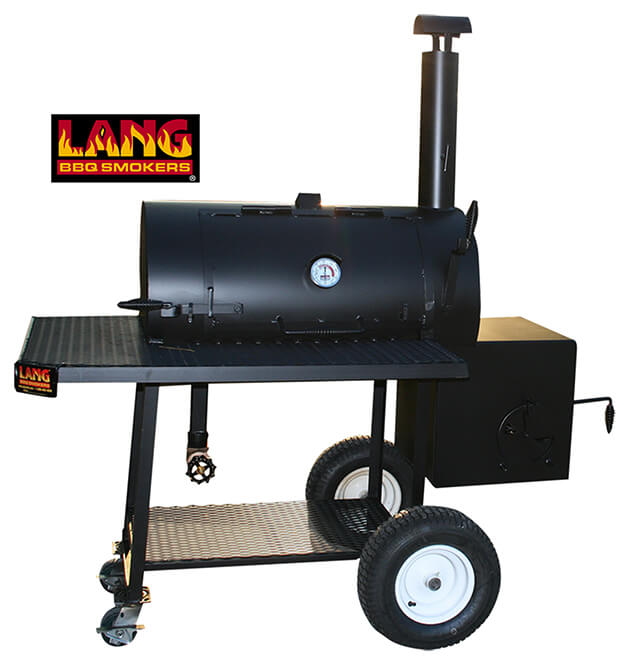 ©Lang BBQ Smokers
©Lang BBQ SmokersAn offset smoker
The firebox is the chamber where wood or charcoal burns. It has a large door for feeding the wood or charcoal in and vents that allow you to adjust the airflow. The fuel sits on a grate at the bottom of the firebox, which allows it to burn cleanly and vent properly.
Offset smokers have been around for a long time. They’re the most common and abundant type of smoker on the market for the general public. They’re very versatile and fairly straightforward to use. And it doesn’t hurt that they’re easy to come by — most companies make some sort of offset smoker. You can find one for $100 or $1,000, depending on what you want to spend.
As an amateur smoker, you won’t go wrong with an offset smoker — it's also one of the best smokers for a beginner. It gives you lots of room for larger cuts of meat and helps you get familiar with the basics of smoking and airflow. When you get better at smoking (and can justify spending more) and understand how your vents work to control airflow, you may consider a more sophisticated offset with a baffle system or a reverse flow.
Offset smokers are preferred in Texas because they’re great air movers and provide a perfect vessel for smoking brisket or beef ribs — products that really need swift airflow to get the best results.Are offset smokers a lot of work? Well, they can be. The cheaper models are loosely built, and heat may not flow as well as it does in a more expensive model. The key is making sure you have a good thermometer placed well, which means about 3 inches up from the grate and somewhere on the unit where it won’t hit the meat you’re cooking.
Regardless of the cooker you use, maintaining an even temperature throughout is important. Even heat is exactly what a smoker with baffles or reverse flow offers you. These features are typically found on bigger units more suitable for an intermediate cook. You may want to cut your teeth on a smaller, cheaper offset to start.
In a standard offset, the area by the firebox that’s the source of your heat gets very hot. In order to lessen this effect or get a more even heat flow, some offsets use tuning plates (rectangular steel plates situated under the grates). You use them to regulate the heat flow up through the body of the cooker. The plates are placed more closely together closest to the firebox and farther apart as distance from the firebox increases.Stacking with a vertical offset
A vertical offset smoker functions like its horizontal counterpart but with an up-and-down body. Its vertical chamber is especially accommodating for meats like sausage or ham that need to hang. The figure below shows a vertical offset smoker.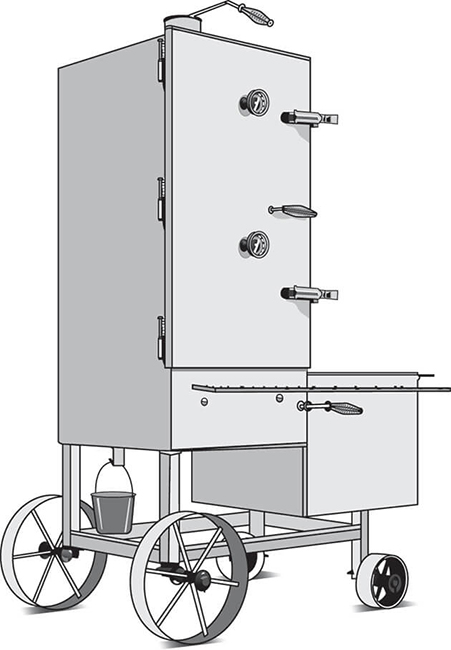 ©John Wiley & Sons, Inc.
©John Wiley & Sons, Inc.A vertical offset smoker
Vertical smokers have great airflow and really move the smoke through the chamber. Because heat rises, it hits every area of the hanging meat, which gives you a fairly even cook. Although it’s hotter at the top, the heat envelops the meat on its way up the chamber.
The fact that the heat rises through the smoking chamber makes a vertical smoker quite efficient. Plus, it has a smaller footprint than a horizontal one. The limiting factor of a vertical offset is that it can’t hold larger cuts like a whole hog.
You have to feed your vertical smoker frequently, which means you can’t step away from your smoker for very long. Even though some have insulated fireboxes, they still need to be fed wood or charcoal about every 45 minutes to an hour.
Making a U-turn with a reverse-flow offset
A reverse-flow offset moves air from the firebox across the body of the smoker and back again to a chimney next to the firebox (see the figure below).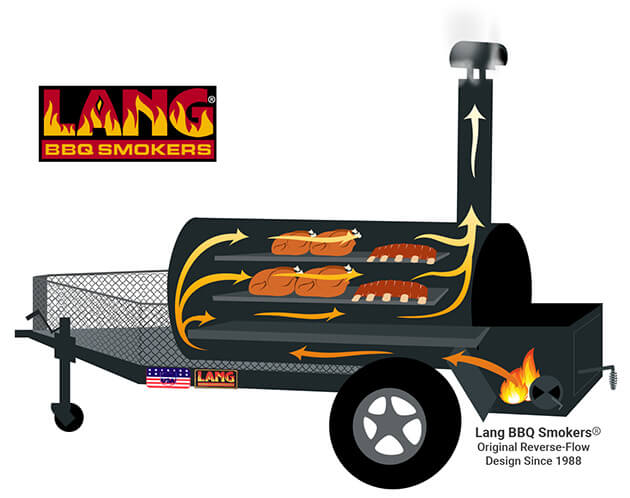 ©Lang BBQ Smokers
©Lang BBQ SmokersA reverse-flow offset smoker
A reverse-flow offset is similar to a regular offset smoker with the exception of the airflow inside the smoker. Typically in a reverse-flow offset, a plate below the grate forces the air to flow down the smoker.
At the far end of the smoker (opposite the firebox) is a gap that allows the air to flow upward. The chimney is placed on the side of the smoker, where the firebox resides, so the air then flows back down the smoker to exit out of the chimney. Basically, the heat flows down the smoker, does a U-turn, and then goes back out the chimney.
Reverse-flow offsets have a solid baffle (a panel for redirecting heat) under the grate that takes the heat all the way to the other end of the cooker. Because the chimney is built into the smoker on the firebox side, air has to travel all the way down the smoker and back to the firebox side.

